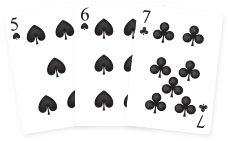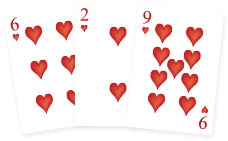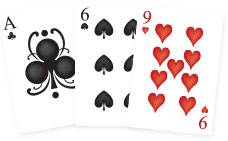How to Play Teen Patti
Teen Patti, which means ‘three cards,’ is a game which originated in India and is now widely played across Southeast Asia. Sometimes also known as Flash or Flush, the game will be familiar to anyone who has played Three Card Brag in the UK and offers players an exciting variation on the more common game of Three Card Poker.
Basic Rules
The game starts with every participant putting an ante into a central pot and then being dealt three cards face down. Players then take it in turns to bet and can decide whether they wish to look at their hand (play seen) or not (play blind).
Players can either put no more money into the pot and fold, therefore surrendering their chances of winning, or make an additional bet (known as chaal). Players who have not looked at their cards must put in at least the current stake and are not allowed to more than double it. The current stake then becomes the amount that has been put in. Players who have looked at their cards must bet at least twice the current stake and not more than four times the current stake. In this scenario, the current stake for the next player becomes half of what has been bet.
The betting continues to go around the table and blind players have the option on their next turn to look at their hand. As the wagering carries on, players may fold until there is just one participant left and they are the winner, or until someone pays for a show, at which point the cards are revealed. The ranking of the possible hands is as follows, from high to low:

Trail (sometimes known as three of a kind, set or trio)
Three cards of the same value, with aces being the best possible hand and twos the lowest.

Pure Sequence (sometimes known as straight flush or straight run)
Three consecutive cards of the same suit, with ace-2-3 the highest. The next best is ace-king-queen, while the lowest pure sequence is 2-3-4. A sequence of two-ace-king is not permitted.

Sequence (sometimes known as straight, run or normal run)
Three consecutive cards which are not all of the same suit, for example a six of spades, seven of diamonds and eight of hearts.

Colour (sometimes known as flush)
Three cards of the same suit that are not in sequence, for example a five, seven and ten of clubs. In a contest between two colour hands, the highest card should be compared. If equal, the middle cards need to be compared, then the lowest. Ace-king-jack is the best possible flush, while 5-3-2 is the lowest.

Pair (sometimes known as two of a kind)
Two cards of the same value, for example a pair of sevens. If two players have the same pair, the odd cards then need to be compared and the highest wins.

High Card
When a player does not have three cards of the same suit, three in sequence or at least two of the same value, the highest card wins. If equal, the middle card needs to be compared, then the lowest. Ace-king-jack of different suits would be the best hand to have in this category.
A show can only occur when there are just two players left who have not folded. Blind players must pay the current stake to force a show, while a seen player cannot demand a show if the other player is blind. They must either fold or keep betting. If both players are seen, either may pay twice the current stake for a show. If the hands turn out to be equal, the player who did not pay for the show wins the pot.
Another option in Teen Patti is the sideshow, or compromise, which can take place before there are only two players left. If you and the player before you are both playing seen, you can ask for a compromise as long as you have enough money to match the current bet and, if they accept, the two of you compare hands. The player with the lowest hand must fold, and if the hands are equal the player who requested the sideshow must fold. If the compromise is declined, the player who wanted the compromise must bet to stay in the game.
Etiquette
When playing Teen Patti, observe the same guidelines on etiquette as you would at any other poker table. Don’t be rude or disrespectful to other players or the dealer and make sure to pay attention.
Make sure you understand the rules before you start playing and stick to your turn. If you want to fold, you may wish to throw your cards back straight away, but wait until the action comes round to your go again. Likewise, if you do fold, don’t talk about your cards while the hand is still in progress.
Strategy
One key decision for Teen Patti players is whether to play blind or look at your cards. By playing blind, you are betting smaller stakes and will not suffer losses as heavy as other players on any given round. However, you are clearly at a disadvantage when you are against a high number of “seen” players as it is unlikely they will all be bluffing about the quality of their hands if they start raising the stakes. Even if they are bluffing, they are doing so from a position of more knowledge.
Bluffing is a huge part of the game because betting must carry on until just one player is left or two participants agree to show. However, the skill is knowing when to carry on wagering and when to cut your losses and fold, and this needs to be dictated by the strength of your hand. There is no shame in folding when you have a weak hand, as you are saving your money for a future round. Conversely, if you have confidence that you will win you may want to keep betting, whilst keeping a close eye on how your competitors are playing. Up against seasoned players, for example, it is recommended that you fold if you only have a low pair rather than trying to bluff.
Sideshows can occur regularly when there is no sign of players wanting to fold, and it is a decent option to take when you believe there is a good chance you have a stronger hand than the player you will be comparing with. Other players at the table will see that you have a relatively decent hand and may be wary of taking you on.
Stakes can grow rapidly, so have clear limits set out when you play about how much you are prepared to spend and stick to your budget.
Where to Play Teen Patti
Teen Patti is most popular in India and other countries in south Asia, particularly around the time of the Hindu festival Diwali. Get in touch if you have ever played Teen Patti or reckon it should be played at UK casinos!
Important terms:
Visit the Casino Glossary to find out more about some of the terms which you might come across when playing Teen Patti.
